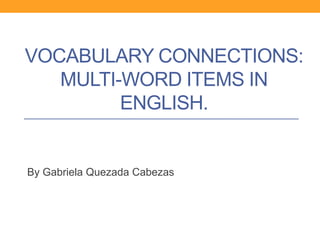
Multi-word items
- 1. VOCABULARY CONNECTIONS: MULTI-WORD ITEMS IN ENGLISH. By Gabriela Quezada Cabezas
- 2. Collocation • Sinclair sets out 2 principles which account for the structural patterning of lexis. Is a way of Is essentiallya traditional seeng language approach to language: text as the result compare slot-and-filler of a very large Open Choice approaches, and the Principle number of distinction between complex choices. syntagm and paradigm. Is that a language user has It restricts the available to him or her a large choices not just number of semi-preconstructed in a given slot, The Idiom phrases that constitute single but in the Principle choices, even though they might surrounding co- appear to be analysable into textual slots segments.
- 3. Multi-word items: terms and categories Multi-word Item • A multi-word item is a Multi word items are the result of vocabulary item which consists lexical (and semantic) processes of of a sequence of two or more fossilisation and word-formation. words. This sequence of words semantically and/or syntactically Rather than the results of the forms a meaningful and operation of grammatical rules inseparable unit.
- 4. Multi-word items: terms and categories • There are three important criteria which help distinguish holistic multi word items from other kinds of string • Is the degree to which a multi-word item is conventionalised in the language. Institutionalisation • Discusses the process and fact of institutionalisation or, in his terms, “lexicalization”. • Is the degree to which a multi-word item is Fixedness frozen as a sequence of words. • Is the degree to which a multi-word item cannot be interpreted on a word-by-word basis, but has Non- a specialised unitary meaning. compositionaly • Non-compositionality can also relate to grammar or pragmatic function.
- 5. Types of Multi-word Item Compounds Are the largest and most tangible group, but the least interesting. They may differ from single words only by being written as two or more orthographic words. They cannot be separated, since variable hyphenation conventions blur the distinction between compound multi-word items and polymorphemic single words. Phrasal Verbs Are combinations of verbs and adbervial or prepositional particles. The verbs are typically monosyllabic. The commonest particles are up and out, followed by off, in, on and down. Phrasal verbs have particular syntactic problems such as the placement of any nominal or pronominal objects with respect to the verb.
- 6. Types of Multi-word Item Idioms They have holistic meanings which cannot be retrieved from the individual meanings of the component words. Idioms are typically metaphorical in historical or etymological terms. Idioms rate highly in terms of non-compositionality. Fixed phrases They include items such as of course, at least, in fact, etc. Many of these are strongly institutionalised, in that they are very high frequency items, and many are strongly fixed. Prefabs Prefabs are preconstructed phrase, phraseological chunks, stereotyped collocations, or semi fixed strings which are tied to discoursal situations and which form structuring devices. Example: The thing/fact/point/ is that… They are institutionalised because they are consistently and frequently used as particular kinds of signal or convention, but they often vary rather than being completely frozen.
- 7. Models of multi-word items Semantics-based Syntax-based The most traditional They attempt to differetiate between categories of multi- Take grammatical well- word items according to formedness as their starting- degrees of compositionality. point. They aim to identify, as it were, the irreducible semantic building-blocks of the lexicon Models provide ways of categorising the different kinds of unit in the lexicon: rather like sorting out chemical compounds from elements.
- 8. Multi-words items and Corpus evidence First generation Second generation Corpora of up to one million words showed limited evidence Corpora of around 20 million for many multi-word items: they words were able to improve on proved simply too rare and too this situation. genre-specific to show up.
- 9. Variability in multi-word items British/American variations (Hold the fort) (Hold down the fort) Varying lexical Unstable verbs component (cost/pay/spend/charge an arm (Throw in the towel/sponge) and a leg) Truncation Transformation (silver lining/every cloud has a (break the ice/ice-breaker/ice silver lining) breaking)
- 10. Multi-word items in text and discourse Multi-word item, text and genre by looking briefly at three extracts (pages 54 and 55) Handbook on Opening of a report Short extract from Painting on a soccer match screenplay This is a higly Technical piece of emotive and writing. evaluative text. This interchange It includes a lot of Multi-word items attempts to compound words. include the replicate natural The multi word item compound speech patterns. chosen reflect the adjective gung-ho It includes genre: technical and some phrasal compounds, terms and clear verbs. informal phrasal signalling of the idioms both verbs, prefabs and structure and clause evaluate and form fixed phrases. relationships. prefaces to evaluations. Multi-word items have important roles with respect with the structure of the text.
- 11. Second-Language learning perspectives Multi-word items are Their non- typically presented as a compositionality, whether problem in teaching and syntactic, semantic or learning a foreign pragmatic in nature, language means that they must be recognised, learned, The phenomena of multi- decoded and encoded as holistic units. Foreign learners word items and idiomaticity are generally are therefore likely held to be universals in to be aware of natural languages. similar phenomena in their firs language.
